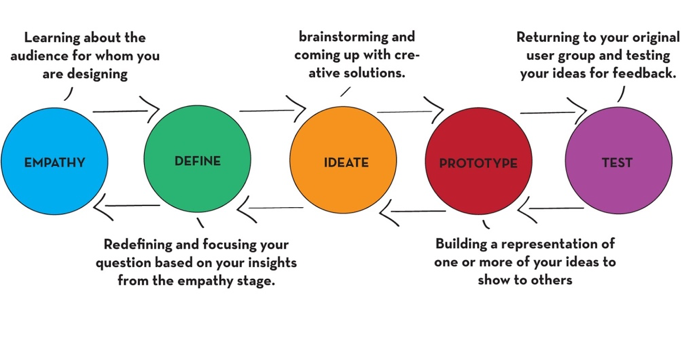
By Seimi Park, Summer Intern
If you enjoy strategy and problem solving as much as we do here at Blue Garnet, odds are that you’re familiar with the term “design thinking.”
Design thinking began as a buzzword in consumer product spaces, at companies like Apple and Nike. In recent years, however, the methodology has been more openly embraced by organizations for which the application of design concepts might seem less intuitive.
The relevance of “design” may not be apparent in the nonprofit and social impact sectors. However, many design thinking principles are innate to the work of social change organizations. So, what exactly is design thinking and how is it applied in the social sector?
Design thinking is a framework for understanding complex problems and creating innovative, human-centered solutions. Unlike most problem-solving methods, design thinking begins with the end in mind – focusing on solutions and the way that things could be, rather than focusing on problems and the way that things currently are.
The design thinking methodology can be captured in five key stages: empathize, define, ideate, prototype, and test.

- Empathize: The design thinking process begins with engaging your end-users or beneficiaries through conversation to develop a richer understanding of their experiences, emotions, needs, and desires. E.g. What are your community members saying about what they really need from your services?
- Define: After gathering insights from your conversations with your end-users, develop an action-oriented problem statement that can be used as a foundation for brainstorming. g. How can you boil down all the point points you heard into prioritized needs?
- Ideate: Spend some time “dreaming up” potential solutions – be creative and think outside the box! E.g. What would you do for and with your client, if you had unlimited resources and abundant staff?
- Prototype: Ask yourself what your potential solutions could look like and translate this vision into something tangible by building models or mock-ups. E.g. Can you test out a pilot project of a new program or service you brainstormed?
- Test: Get feedback from your users on what works and more importantly, what needs improvement. E.g. How did the pilot project meet the community needs identified?
While the methodology can be broken down into these five stages, the process of design thinking is never quite complete, requiring constant iteration. In other words, you’ll likely go through the process multiple times before you generate a viable solution.

The Blue Garnet team after an energizing brainstorming session on ways we can continue to employ design thinking in our work
Here are a few examples of how Blue Garnet uses design thinking principles in our work:
- People come first. In order to maximize our impact, we focus on better understanding our clients and the communities that they serve. Our work is centered on developing meaningful relations with our clients, learning about the experiences of stakeholders, and putting ourselves in the shoes of the Southern California community through innovative techniques, such as empathy mapping.
- Starting with the end in mind. When we work with clients, we begin by asking questions: What social impact are you hoping to achieve? How will you measure your impact? What do you need to hone to make this impact possible? We believe that defining your desired impact is critical to ensuring the sustainability and efficacy of your organization.
- In order to truly think outside of the box, assume nothing. Don’t limit yourself to conventionality and that which has already been done. Every client is unique. We don’t problem-solve by relying on precedent – rather, we problem-solve by learning from our clients about their individual needs and working through the defining and brainstorming stages of the design thinking process
- Continuously iterate. Always ask yourself, “What can we do better?” There is rarely a definitive “end” point to our work in the social impact space. As a “team of learners,” we are continuously thinking of ways to better support our clients and communities.
At our social impact consulting firm, human-centered problem solving has been woven into the Blue Garnet-DNA. As we continue learning and growing, we would love to hear from you. How are you thinking about design thinking principles in your own organization? Let us know your thoughts at hello@bluegarnet.net.
Further resources on Design Thinking:
Design Thinking for Greater Good: Innovation in the Social Sector. Liedtka, Salzman, and Azer https://www.amazon.com/Design-Thinking-Greater-Good-Innovation-ebook/dp/B0719PRBM5
“Bringing Design Thinking To Social Problems, Ideo.org Focuses on the People in Need.” Pastorek https://www.fastcompany.com/3020789/bringing-design-thinking-to-social-problems-ideoorg-focuses-on-the-people-
“Design Thinking for Social Innovation.” Brown and Wyatt https://ssir.org/articles/entry/design_thinking_for_social_innovation
